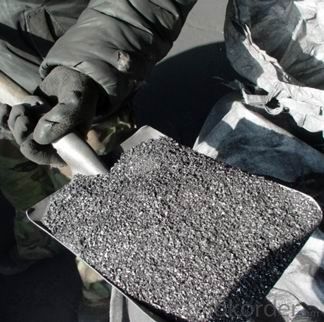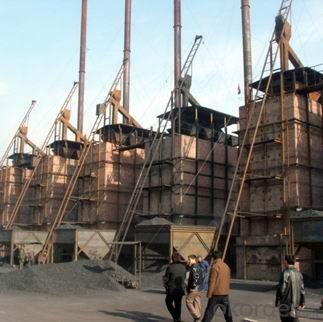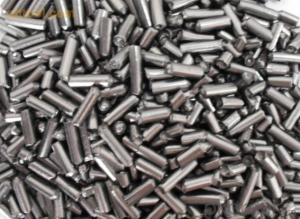Calcined Anthracite Coal Carbon Additive FC 90-95%
- Loading Port:
- Tianjin
- Payment Terms:
- TT or LC
- Min Order Qty:
- 20 m.t.
- Supply Capability:
- 10000 m.t./month
OKorder Service Pledge
OKorder Financial Service
You Might Also Like
Quick Details
Place of Origin: Ningxia, China (Mainland)
Application: steel making
Shape: granule
Dimensions: FC90-95%
Product Type: Carbon Additive
C Content (%): 90-95% MIN
Working Temperature: -
S Content (%): 0.5%MAX
N Content (%): -
H Content (%): 0.6%MAX
Ash Content (%): 8.5%MAX
Volatile: 2%MAX
ADVANTAGE: low ash & sulfur
COLOR: Black
RAW MATERIAL: TaiXi anthracite
Packaging & Delivery
| Packaging Details: | In 1MT plastic woven bag. |
|---|---|
| Delivery Detail: | 30-40DAYS |
Specifications
Calcined Anthracite Coal Carbon Additive FC 90-95%
Carbon Additve low Ash,S,P
FC>95% ASH<4% S<0.3%
It is made from TaiXi anthracite.
instead of pertrol coke reduce the cost
Structure
Calcined Anthracite Coal Carbon Additive FC 90-95%
Shape: granule
Dimensions: FC90-95%
Product Type: Carbon Additive
C Content (%): 90-95% MIN
Working Temperature: -
S Content (%): 0.5%MAX
N Content (%): -
H Content (%): 0.6%MAX
Ash Content (%): 8.5%MAX
Volatile: 2%MAX
ADVANTAGE: low ash & sulfur
COLOR: Black
RAW MATERIAL: TaiXi anthracite
Feature
Calcined Anthracite Coal Carbon Additive FC 90-95%
Specifications (%): | ||||||
Grade | F.C | Ash | V.M | Moisture | S | Size |
CR-95 | ≥95 | <4 | <1 | <1 | <0.3 | 0-30mm |
CR-94 | ≥94 | <4 | <1 | <1 | <0.3 | |
CR-93 | ≥93 | <6 | <1 | <1 | <0.4 | |
CR-92 | ≥92 | <7 | <1 | <1 | <0.4 | |
CR-91 | ≥91 | <8 | <1 | <1 | <0.4 | |
CR-90 | ≥90 | <8.5 | <1.5 | <2 | <0.4 | |
Image
Calcined Anthracite Coal Carbon Additive FC 90-95%


FAQ:
Calcined Anthracite Coal Carbon Additive FC 90-95%
Why we adopt carbon additive?
Carbon Additives used as additive in steel making process. It made from well-selected Tai Xi anthracite which is low in content of ash, sulphur, phosphorus, high heat productivity, high chemically activation.
Mainly industry property of it is: instead of traditional pertroleum coal of Carbon Additives, reduce the cost of steelmaking.
Advantage:
Calcined Anthracite Coal Carbon Additive FC 90-95%
1.High quality and competitive price.
2.Timely delivery.
3.If any item you like. Please contact us.
Your sincere inquiries are typically answered within 24 hours.
- Q:How does carbon affect the formation of desertification?
- Carbon does not directly affect the formation of desertification. Desertification is mainly caused by a combination of natural factors such as climate change, prolonged drought, and human activities like deforestation and overgrazing. However, carbon indirectly plays a role in exacerbating desertification through climate change. Carbon dioxide (CO2) is a greenhouse gas that is released into the atmosphere through human activities, primarily the burning of fossil fuels. The increased concentration of CO2 in the atmosphere leads to global warming, which alters climate patterns and increases the frequency and intensity of droughts. Prolonged droughts can cause soil moisture depletion, making the land more susceptible to erosion and degradation, thus contributing to the desertification process. Moreover, carbon indirectly affects desertification through deforestation. Trees and other vegetation play a crucial role in maintaining healthy soil by preventing erosion, retaining moisture, and providing shade. When forests are cleared, the carbon stored in trees is released into the atmosphere, contributing to increased CO2 levels. Additionally, the loss of vegetation cover exposes the soil to erosion by wind and water, accelerating desertification. It is important to note that while carbon indirectly impacts desertification through climate change and deforestation, desertification itself is a complex process influenced by various factors. Addressing desertification requires a comprehensive approach that involves sustainable land management practices, reforestation efforts, water management, and climate change mitigation strategies.
- Q:How is carbon stored in the Earth's crust?
- Various forms of carbon are stored in the Earth's crust through different geological processes. One primary method of storage involves the creation of sedimentary rocks like limestone, dolomite, and chalk. These rocks consist mainly of calcium carbonate, which comes from the shells and skeletons of marine organisms that existed millions of years ago. As time passes, these remains gather on the ocean floor and become compressed and cemented, effectively trapping carbon within them. Another way carbon is stored in the Earth's crust is through carbonation. Carbon dioxide (CO2) from the atmosphere can dissolve in water and react with specific minerals, like basalt, leading to the formation of carbonate minerals such as calcite or magnesite. This natural process occurs through chemical weathering and volcanic activity, aiding in the sequestration of carbon within the Earth's crust. Moreover, organic carbon takes the form of fossil fuels, including coal, oil, and natural gas. These fuels are the remnants of ancient plants and microorganisms that lived and perished millions of years ago. Over time, the organic matter becomes buried and subjected to high pressure and temperature, resulting in a process known as diagenesis, which eventually converts it into fossil fuels. These deposits serve as carbon reservoirs within the Earth's crust. In summary, the Earth's crust acts as a significant carbon sink, efficiently storing carbon through processes such as the formation of sedimentary rocks, carbonation, and the accumulation of fossil fuels. However, it is crucial to note that human activities, particularly the combustion of fossil fuels, are releasing substantial amounts of stored carbon into the atmosphere, contributing to global climate change.
- Q:What is the role of carbon in organic chemistry?
- Carbon is the backbone of organic chemistry as it has the unique ability to form covalent bonds with other carbon atoms and a wide variety of other elements, resulting in the vast diversity of organic compounds. It is the element that allows for the formation of complex molecules, such as carbohydrates, proteins, lipids, and nucleic acids, which are essential for life processes.
- Q:How does carbon impact the fertility of soil?
- Carbon plays a crucial role in the fertility of soil as it is the foundation of organic matter, which is vital for soil health and productivity. When carbon-rich organic matter, such as decaying plant and animal residues, is added to the soil, it helps improve its structure, nutrient-holding capacity, and water retention. This, in turn, enhances the soil's ability to support plant growth and sustain microbial activity. Organic matter serves as a source of carbon for soil microorganisms, fungi, and bacteria, which decompose it and release nutrients for plants. This decomposition process, known as mineralization, releases essential macronutrients (nitrogen, phosphorus, and potassium) and micronutrients into the soil, making them available for plant uptake. Additionally, carbon in organic matter helps bind soil particles together, improving soil structure and preventing erosion. Moreover, carbon improves the soil's water-holding capacity, reducing the risk of drought stress for plants. It acts as a sponge, absorbing and retaining moisture, which helps to sustain plant growth during dry periods. Carbon also promotes the development of a healthy and diverse soil microbial community, including beneficial bacteria and fungi. These microorganisms enhance nutrient cycling, disease suppression, and plant nutrient uptake, further contributing to soil fertility. However, excessive carbon inputs, such as from excessive organic matter addition or improper land management practices, can have negative effects on soil fertility. An imbalance in carbon availability can lead to nitrogen immobilization, where soil microorganisms consume nitrogen for their own growth, depriving plants of this essential nutrient. Additionally, high carbon content can create anaerobic conditions, reducing the availability of oxygen for plant roots and beneficial soil organisms. In summary, carbon is essential for maintaining soil fertility as it improves soil structure, nutrient availability, water retention, and microbial activity. However, it is crucial to maintain a balanced carbon-to-nitrogen ratio and adopt sustainable land management practices to ensure the optimal fertility of soil.
- Q:How is carbon involved in the metabolism of carbohydrates, proteins, and fats?
- Carbon is involved in the metabolism of carbohydrates, proteins, and fats by serving as the foundational element in these macromolecules. Carbon atoms form the backbone of these molecules, allowing for the attachment of other functional groups such as oxygen, hydrogen, and nitrogen. Through various metabolic pathways, carbon atoms are broken down or rearranged to release energy or to build new molecules, facilitating the conversion of carbohydrates, proteins, and fats into usable forms for the body.
- Q:How does carbon dioxide affect the pH of soil?
- Carbon dioxide can affect the pH of soil through a process called carbonation. When carbon dioxide dissolves in water, it forms carbonic acid (H2CO3), which is a weak acid. When this acid is present in soil, it can react with certain minerals and compounds, such as limestone or calcium carbonate, found in the soil, resulting in their dissolution. This process releases positively charged ions, such as calcium (Ca2+) or magnesium (Mg2+), into the soil solution, which can increase the soil's alkalinity or raise the pH. Additionally, the presence of carbonic acid can also increase the availability of certain nutrients in the soil. For example, it can enhance the solubility of phosphorus, making it more accessible for plants to uptake. This can lead to an increase in soil fertility. However, it is important to note that the effect of carbon dioxide on soil pH can vary depending on different factors, such as the concentration of carbon dioxide, soil type, and the presence of buffering agents. In some cases, the buffering capacity of the soil can limit the impact of carbonic acid on pH changes. Therefore, while carbon dioxide can influence soil pH, it is just one factor among many that can affect the overall acidity or alkalinity of soil.
- Q:What is carbon nanoelectronics?
- Carbon nanoelectronics refers to the field of research and development that focuses on utilizing carbon-based materials, such as carbon nanotubes or graphene, for the creation and advancement of electronic devices and components on a nanoscale level. These nanoscale carbon structures possess unique electrical properties that make them highly desirable for applications in a wide range of electronic devices, including transistors, sensors, and interconnects. One of the key advantages of carbon nanoelectronics is the exceptional electrical conductivity and thermal properties of carbon nanomaterials. Carbon nanotubes, for instance, exhibit excellent electrical conductivity, comparable to copper, but with a much smaller footprint. This property allows for the creation of smaller and more efficient electronic devices, leading to advancements in areas such as miniaturization and energy efficiency. Another noteworthy aspect of carbon nanoelectronics is the immense strength and flexibility of carbon nanomaterials. Carbon-based structures like graphene possess exceptional mechanical properties, making them highly durable and resilient. This property enables the production of flexible and wearable electronic devices that can conform to various surfaces, opening up new possibilities for electronics design and integration. Additionally, carbon nanoelectronics offers the potential for high-speed and low-power electronic devices. The unique electronic properties of carbon nanomaterials, such as their ability to carry electric charge at an extremely high speed, make them suitable for high-frequency applications. Furthermore, the low power consumption of carbon nanomaterials can lead to the development of energy-efficient electronic devices. Overall, carbon nanoelectronics holds great promise for revolutionizing the field of electronics by enabling the creation of smaller, faster, and more energy-efficient devices. Continued research and development in this field are expected to lead to breakthroughs in various industries, including computing, telecommunications, healthcare, and energy.
- Q:What are the impacts of carbon emissions on the stability of mountains?
- Carbon emissions have significant impacts on the stability of mountains. One of the most prominent impacts is the acceleration of global warming, which leads to the melting of glaciers and permafrost. As mountains are home to many glaciers, the increase in temperature causes these glaciers to melt at an alarming rate. This melting can result in the destabilization of mountains, leading to increased landslide and rockfall activity. Furthermore, carbon emissions contribute to the acidification of rainwater. Acid rain can erode the rocks and soil in mountains, weakening their stability. This erosion can lead to slope instability, making mountains more susceptible to landslides and other forms of mass movements. Additionally, carbon emissions contribute to changes in precipitation patterns. Mountain ecosystems heavily rely on a delicate balance of rainfall and snowfall. However, climate change caused by carbon emissions disrupts this balance, leading to altered precipitation patterns. This can result in increased water runoff and a reduction in snowpack, both of which contribute to mountain destabilization. Moreover, carbon emissions have indirect impacts on mountain stability through changes in vegetation patterns. As temperatures rise, plant species may migrate to higher altitudes in search of cooler climates. This can result in the loss of vegetation in lower elevation areas, which play a crucial role in stabilizing slopes and preventing erosion. The absence of plant cover leads to increased soil erosion, leaving mountains more vulnerable to landslides and other erosive processes. In conclusion, carbon emissions have detrimental impacts on the stability of mountains. The acceleration of global warming, acidification of rainwater, altered precipitation patterns, and changes in vegetation patterns all contribute to the destabilization of mountains. It is crucial to reduce carbon emissions and mitigate climate change to protect and preserve these majestic natural formations.
- Q:How do fossil fuels release carbon dioxide when burned?
- When fossil fuels are burned, the carbon atoms present in them combine with oxygen from the air, resulting in the release of carbon dioxide (CO2). This process, known as combustion, produces energy and water vapor as byproducts.
- Q:How does carbon affect the pH of water?
- Carbon can affect the pH of water through the process of carbonation. When carbon dioxide (CO2) dissolves in water, it reacts with the water molecules to form carbonic acid (H2CO3). This reaction increases the concentration of hydrogen ions (H+) in the water, resulting in a decrease in pH. Therefore, carbonation lowers the pH of water, making it more acidic. Additionally, carbonic acid can further dissociate into bicarbonate ions (HCO3-) and hydrogen ions (H+), which also contribute to the increase in acidity. It is important to note that the impact of carbonation on pH depends on the concentration of carbon dioxide present in the water.
1. Manufacturer Overview |
|
|---|---|
| Location | |
| Year Established | |
| Annual Output Value | |
| Main Markets | |
| Company Certifications | |
2. Manufacturer Certificates |
|
|---|---|
| a) Certification Name | |
| Range | |
| Reference | |
| Validity Period | |
3. Manufacturer Capability |
|
|---|---|
| a)Trade Capacity | |
| Nearest Port | |
| Export Percentage | |
| No.of Employees in Trade Department | |
| Language Spoken: | |
| b)Factory Information | |
| Factory Size: | |
| No. of Production Lines | |
| Contract Manufacturing | |
| Product Price Range | |
Send your message to us
Calcined Anthracite Coal Carbon Additive FC 90-95%
- Loading Port:
- Tianjin
- Payment Terms:
- TT or LC
- Min Order Qty:
- 20 m.t.
- Supply Capability:
- 10000 m.t./month
OKorder Service Pledge
OKorder Financial Service
Similar products
New products
Hot products
Hot Searches






























